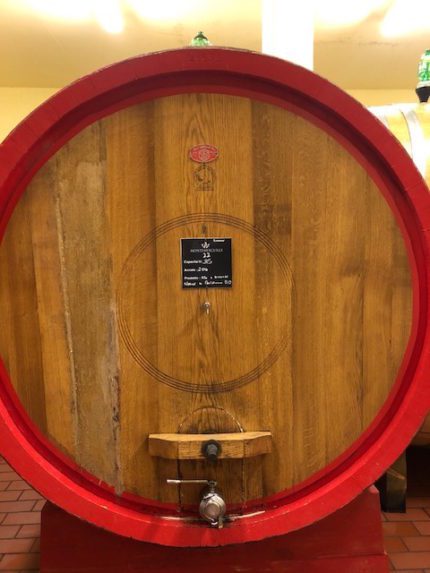Delving into the History of Montepulciano Wine: A DOCG in Need of a Bigger Voice
We hired “Just in Tuscany”, a service that does private wine tours and hiking trips in the region, to take us to Montepulciano, a region that I wanted to explore more.
Montepulciano is a medieval and Renaissance town located in the province of Siena in Southern Tuscany. It is known for wine, food and drink and has been growing grapes for generations – back in the days of the Etruscans. The hillside village is known for Vino Nobile di Montepulciano or wine of the noblemen.
It’s least known of the other well-known Tuscan DOCGs (think Chianti Classico and Brunello di Montalcino), but they are delightful wines in their own right. Some 2,500 acres are planted with vines, most of them with the local Sangiovese strain called Prugnolo. An important thing to distinguish is that this is different than the grape varietal Montepulciano, which is ubiquitous throughout southern and central Italy. The region is also known for Rossi di Montepulciano wines, made with the grapes of younger vineyards near Montepulciano and then there were some surprises like Vino Santo.
History of Montepulciano Wine
Manuele De Bellis, Guide from Just in Tuscany
Our Sommelier guide, the knowledgeable Manuele De Bellis, took us to three wineries that were very distinct and showcased the diversity of the region.
History of Montepulciano Wine
The Incredibly Hospitable Natalini Family – Andrea and Mamma
Our first stop was a small, true family run winery. Le Bèrne’s farm is situated in the countryside of southern Tuscany. In 1960, Egisto Natalini and his son, Giuliano, started the winery at the end of the Italian share-cropping system and grew grapes before making the first wines in 1997. Giulliano’s son, Andrea joined the business in 1995 and works with Oenologist Paolo Vagaggini. The vineyards on the Poderne Le Bèrne occupy 10 hectares of the 21 owned by the family – which produce Vino Nobile, Rosso di Montepulciano and Vin Santo di Montepulciano. The tasting room was added in 2004 where the estate olive oil can also be sampled.
The starter Vin Santo
As we walked the vineyard and saw the production techniques, you could see a mix of Old World and modern techniques coming together. Especially as we saw how the Vin Santo, a late-harvest wine made with Pulcinculo or Malvasia, was dried, pressed on wicker and fermented using a Mother starter yeast that was 400 years old with Vin Santo from a previous production and then stored in barrels for another seven years in a Tuscan attic.
We tasted through the line-up and I really enjoyed the wines. I was in tourist versus blogger mode, so I wasn’t taking detailed tasting notes, but I did leave with several bottles. The Vin Santo, named after “Mamma Ada,” is fruity, deep, with notes of honey, spice, raisin and notes of caramel.
We then moved to Fattoria della Talosa, one of the first wineries in Montepulciano to put the region on the map for quality Vino Nobile di Montepulciano wines. In 1972, Angelo Jacorossi acquired the winery and invested heavily in upgrading the facility. The 32 hectares of Talosa’s vineyards are located in Pietrose, at an altitude of 350-400 meters above the sea level, and are known for sandy soil.
Nicolas took us through the historic cellar, which is located between Via Talosa and Piazza Grande, and dates its origins date back to Etruscan times. The Talosa Cellar dates back to the 16th century and as we walked through the brick passageways and looked at the huge oak barrels where the wine is aged, you understand the sense of history.
We had a chance to try five wines over a lovely lunch. Again, I was in tourist versus blogger mode, but we have a case of wine coming our way when the weather breaks in November.
Our final stop was at Montemercurio, which was my favorite stop of the day because I loved the “mad scientist” meets Old World tradition driven by Marco Anselmi. The estate is a homage to Marco’s grandfather, Damo, who planted many of the vines over 60 years ago. Fifty years later, the most precious grapes are being used in the “Vino Nobile Damo D.O.C.G.” dedicated in memory of Damo who started the dream that has become a reality for the Anselmi family.
Marco was just 19 when he started working at the winery, but in 11 years, he’s made his mark from making the vineyards certified organic; by using wild yeast and minimal sulfites and filtration; and aging the wines longer than most other winemakers (love this trend, but it’s expensive).
Irene Lesti, who held many roles including marketing and hospitality, took us through a tasting of these fantastic and diverse wines that I fell in love with. It took us a long time to decide what to order as we wanted them all. It is clear that Marco has a love for Tuscany, a respect for tradition, a push for innovation and a need to make a mark for his family in Montepulciano.
Powered byTwitter





















